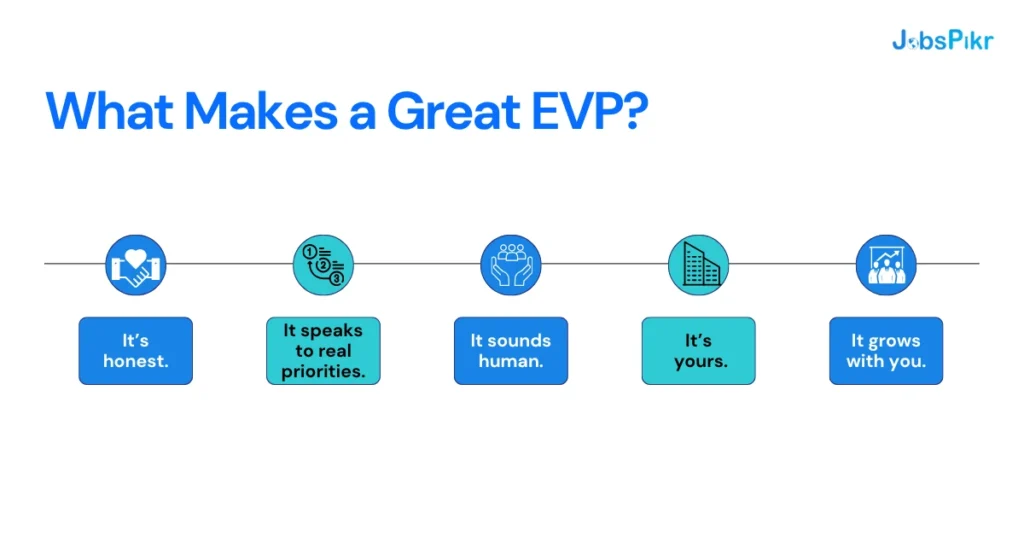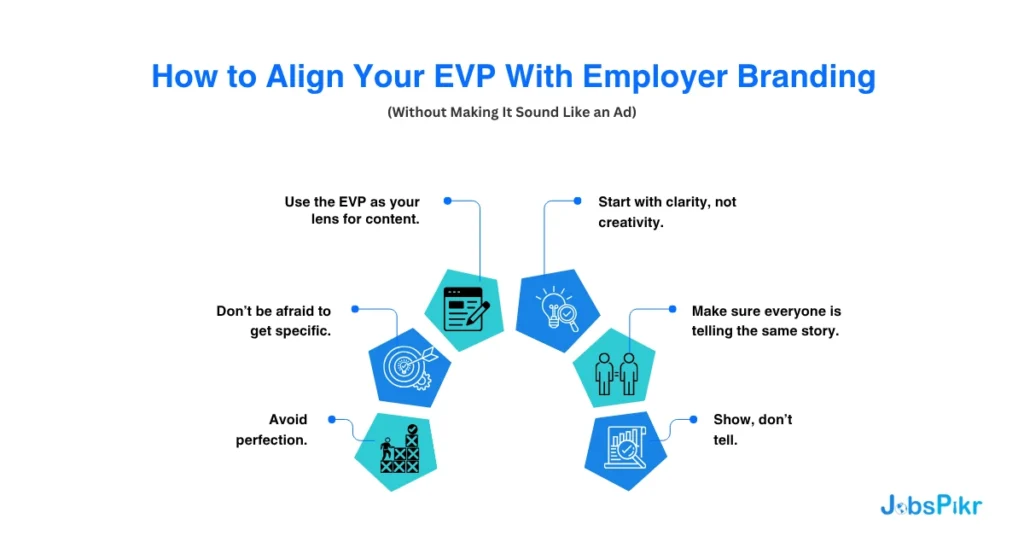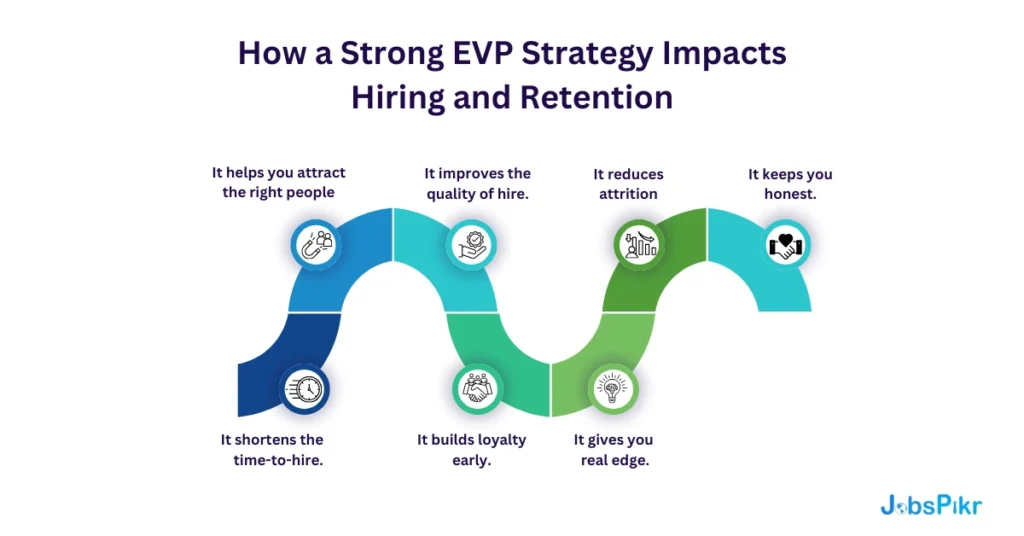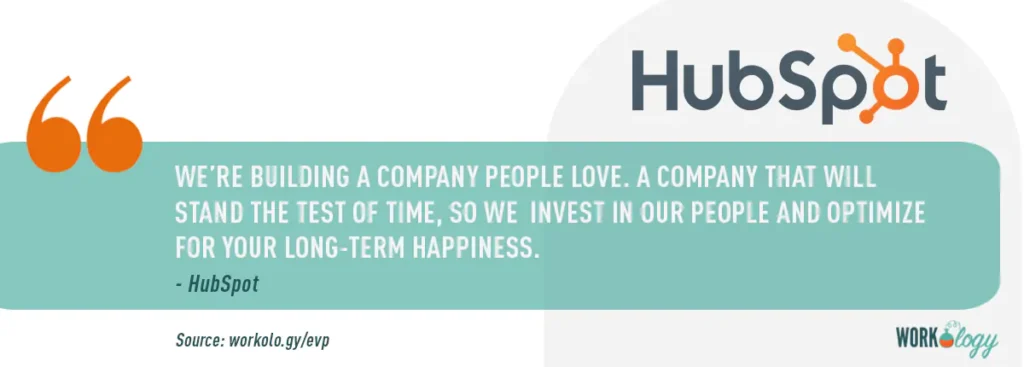If you’re trying to hire smart people right now, you’ve probably realized it’s not just about paychecks anymore. Talented folks have options, and they’re choosing companies that get them. That’s where your EVP strategy comes in.
Your Employee Value Proposition (EVP) is basically the answer to one big question every candidate is silently asking: “Why should I work for you?” And no, “we offer a competitive salary” doesn’t cut it. A strong EVP covers the full experience—culture, growth, work-life balance, purpose, and yes, compensation too.
So why build an actual EVP strategy? Because without one, you’re guessing. You’re posting job ads that don’t reflect who you are. You’re attracting the wrong people—or worse, no one at all. And in a market where every company is shouting to be heard, silence isn’t an option.
Here’s the truth: companies with a clear, well-communicated EVP aren’t just filling roles faster. They’re hiring people who stay longer and actually want to be there. One Gartner stat that gets thrown around a lot—but for good reason—is that a strong EVP can cut employee turnover by nearly 70%. That’s huge.
And remember, this ties right into employer branding. Your EVP is the substance. Employer branding is how you tell the story. If you get the EVP wrong, the branding is just lipstick on a pig.
Bottom line? If you’re not actively developing an EVP strategy, you’re already behind. Because your competitors probably are.
What Makes a Great EVP? It’s Not Just Perks and Ping-Pong Tables

Let’s be honest: most companies claim to have an EVP, but a lot of them sound the same. “We care about our people.” “We’re a family.” “We offer great work-life balance.” Cool. But so does literally every company on LinkedIn.
So what actually makes an EVP stand out? It’s not your gym reimbursement or bean bags in the breakroom. A great employee value proposition is about who you really are, and why someone should pick you over the dozen other offers they probably have.
Here’s what separates a throwaway EVP from one that actually attracts talent:
It’s honest.
An organization that thrives on rapid turnover and a hint of disorder does not owe its recruits a polished image of serenity. A candidate somewhere craves that very tempo. The employee-value proposition ought to capture the workplace pulse as it exists, rather than the glossy portrait sketched in a strategy deck. Honest previews cut turnover because newcomers immediately recognize the environment they are choosing.
It speaks to real priorities.
People are not leaving jobs because they didn’t get a tote bag. They leave because of bad managers, no growth, or a sense of being just another cog. Your EVP should directly answer what today’s candidates care about: Do I have purpose here? Will I grow? Am I respected? Is my time valued?
It sounds human.
Ditch the jargon. “World-class culture” and “synergistic teams” mean nothing. If your EVP sounds like it was written by a committee, candidates will scroll right past it. Use real language. Speak like a person, not like a press release.
It’s yours.
No borrowing lines from Google or Netflix. No copying what your competitor says on their careers page. A great EVP strategy reflects your unique DNA—your quirks, your values, your people. If it could be printed on someone else’s website and still make sense, it’s not your EVP.
It grows with you.
The EVP you had when you were a 10-person startup? That’s not going to work when you’re 500 people deep and in four time zones. Your EVP should grow as your company does. What matters to your people now might not be what mattered two years ago—and that’s okay. Just keep listening, and keep evolving it.
Here’s the goal: you want someone to read your EVP and go, “Yes. That sounds like a place where I’d want to work.” Not because you promised free kombucha or unlimited PTO, but because you spoke to something real.
How to Develop an EVP Strategy That Attracts Talent
Let’s not overcomplicate this. A good EVP strategy isn’t built in a branding workshop with six stakeholders and a mood board. It’s built by listening. Asking the right questions. Getting brutally honest about what you’re offering—and who you’re offering it to.
Here’s how you build one that lands with people:
Start with your people, not a positioning deck.
Want to know what your EVP already is? Ask your employees. Ask the ones who stay. Ask the ones who left. Ask the new hires why they joined. What are they getting here that they didn’t get somewhere else? What’s missing? You’ll get more insight from five raw exit interviews than a whole strategy doc made in a vacuum.
Figure out what makes your company different—and say it clearly.
Your company doesn’t need to be perfect. But it does need to be specific. Are you scrappy and fast-moving? Great. Are you structured and process-driven? That’s fine too. Own it. There’s talent out there looking for both. What kills interest is a middle-of-the-road EVP that says absolutely nothing.
Make it a decision filter, not just a tagline.
The whole point of an EVP is to help people decide: Is this for me or not? If your EVP is doing its job, it won’t appeal to everyone. That’s the point. A good EVP draws the right people in and filters the wrong ones out. If it’s too safe, too generic, or too watered down, it’s not helping you hire—it’s just adding noise.
Align it with the reality of the job.
Candidates don’t care about what’s written on your “culture” page. They care about what it’s actually like on Monday morning when they log in. If your EVP promises growth, your managers better be having career conversations. If you say you’re people-first, don’t cancel every one-on-one. If the EVP and the employee experience don’t match, people will leave—and worse, they’ll talk about it.
Test it in the wild.
Once you’ve drafted something, don’t just slap it on your careers site. Try it in a job ad. Use it in interviews. Talk about it in onboarding. See how people respond. Do they nod? Do they light up? Do they call it out in feedback? If not, you’re not there yet.
Work with marketing
Sure, employer branding and marketing can help you shape the message. But this isn’t a campaign—it’s your promise to people. HR and TA need to own it. Because you’re the ones who have to deliver on it.
Keep checking in.
Your EVP is a living thing. As your company grows, your talent needs shift. So should your EVP. What worked last year might not fit the team you’re building now. Review it regularly. Update the language. Get fresh input from employees. Keep it honest. Keep it relevant.
How to Align Your EVP Strategy With Employer Branding (Without Making It Sound Like an Ad)
Let’s be real: most employer branding efforts end up sounding like a marketing campaign. Slick words, pretty videos, but zero substance. That’s what happens when your EVP strategy and your employer branding aren’t actually connected. The messaging feels forced, the careers page reads like a brochure, and candidates tune out.
But when you align the two the right way? You get something that feels real—and more importantly, works.
Here’s how to do it without turning your EVP into ad copy:

Start with clarity, not creativity.
The temptation is to make your employee value proposition sound cool. Don’t. Make it sound true. Your branding should bring the EVP to life, not rewrite it to win awards. If your EVP says people have autonomy, show that in your content. Feature employees telling real stories about how they take ownership.
Make sure everyone is telling the same story.
If recruiters are pitching one version of life at your company, but hiring managers are saying something else, you’ve got a problem. Everyone who represents your brand—on LinkedIn, in interviews, at events—should be aligned on what your EVP is. That’s when employer branding gets consistent and powerful. Otherwise, it’s just noise.
Show, don’t tell.
Don’t just say “We support growth.” That’s vague and overused. Instead, feature someone who started as a junior dev and is now leading a product team. Don’t say “We care about flexibility.” Show a real-life example of someone working remotely from another city while managing a team across time zones. That’s EVP employer branding done right.
Use the EVP as your lens for content.
What do you post on your careers page, your social feeds, and your email sequences to candidates? Filter it all through your EVP. If your value proposition is about learning and experimentation, post about the hackathons and failed experiments. If it’s about mission-driven work, talk about customer impact. When you do this well, every touchpoint starts to feel like it’s coming from the same place.
Don’t be afraid to get specific.
The more specific you are, the more your brand feels real. Talk about your team rituals. Share the internal jokes. Show the Slack culture. That kind of detail builds trust because it feels like an inside look, not a generic campaign.
Avoid perfection.
People trust brands that feel honest, not polished. If you’re still figuring some things out as a company, that’s okay to say. You can be aspirational without pretending you’ve arrived. Candidates aren’t expecting perfection. They’re expecting honesty. The best EVP-aligned brands are confident enough to admit they’re a work in progress.
When your EVP and employer brand are aligned, something clicks. You’re no longer convincing people to apply. You’re just showing them who you are—and letting the right ones say, “That sounds like a place where I’d thrive.”
How a Strong EVP Strategy Impacts Hiring and Retention
Here’s the truth, most companies figure out too late: recruiting isn’t hard because there’s a lack of talent. It’s hard because the best people have options, and if your offer doesn’t stand out, they’ll walk. That’s where a strong EVP strategy makes the difference.
It’s not just a branding play. It’s a practical tool for making better hires, faster, and keeping them around longer.

It helps you attract the right people, not just more people.
A well-crafted employee value proposition attracts people who belong in the room. It does more than inflate head counts; it pulls in individuals likely to find purpose in their work.
Recruiters can spend freely on ads, yet the spend becomes frivolous if the core message is muddled. Posting without clarity is little more than noise disguised as outreach.
It shortens the time-to-hire.
When the offering is lucid, the incoming candidate pool is self-filtering. Individuals arrive already convinced that the culture, mission, and perks align with their career stories. The fit is instinctive, so skipping stages of the process becomes possible.
Clear communication also trims calendar time. Believers in the message move faster through interviews because they require less convincing. That compression of steps cuts negotiation back-and-forth and limits the number of offers declined on principle.
It improves the quality of hire.
When you’re attracting people who genuinely align with your culture, they tend to ramp faster and contribute sooner. They don’t need six months to “adjust”—they already know what they signed up for. And they’re more likely to be energized by the work, not drained by the mismatch.
It builds loyalty early.
Here’s something a lot of companies miss: your EVP starts influencing retention before day one. When someone joins because they believe in the experience you promised, and you deliver on that promise? You build trust. Early. That’s the kind of foundation that turns new hires into long-term employees.
It reduces turnover and the cost that comes with it.
High turnover isn’t just an HR headache. It costs money. It drains morale. It slows down teams. According to Gallup, the cost of replacing an employee can range from half to two times their annual salary. If your EVP helps you hold onto good people for just a year longer, that’s a massive financial win.
It gives your recruiters and hiring managers a real edge.
When everyone on your hiring team is aligned on what your company stands for, and how to talk about it, your message becomes sharper. You’re no longer pitching vague “opportunities” or relying on generic phrasing. You’re giving candidates something to believe in—and that matters more than ever.
And maybe most importantly…
It keeps you honest.
A well-built EVP strategy forces you to look in the mirror. If you’re promising growth, but there’s no learning budget? If you say you’re remote-first but require people to “pop into the office” three times a week? The disconnect will kill your credibility. A strong EVP only works when it’s real, and building one makes you tighten up the experience so it is.
So yeah, a great EVP won’t magically solve every hiring challenge. But it will give you an unfair advantage in a noisy, competitive market. Because in the end, people don’t just want a job. They want to believe they’re choosing a place where they’ll matter.
EVP and Culture: How to Build an EVP That Reflects Who You Are
Job seekers are growing weary of firms that sell a story and then rewrite the script the moment an offer is signed. Picture booking a sun-soaked retreat, only to discover a gravel lot beside a roar of traffic. That disconnect is the hallmark of an employee value proposition that collides with the observable culture.
The task is not to construct an EVP that sparkles on a company homepage; the real work is in describing what actually is. It must capture the shared values, the odd habits, the prevailing management tone, the admitted shortcomings-and, most important, the lived rhythm of the average workday.
Here’s how to make that happen:
Listen before you write.
You can’t build a real employee value proposition if you’re guessing. Skip the ivory-tower brainstorms. Start with your people. Run interviews, pulse surveys, and exit interviews. Ask:
- Why did you join?
- Why did you stay?
- What frustrates you here?
- What makes you proud to work here?
Avoid the temptation to showcase only the highlights. An authentic employee value proposition emerges from the uneven, sometimes awkward, reality of daily life inside your organization. Enclose the stressful projects, the ad hoc team lunches, and the occasional technological hiccup alongside the wins. Those imperfections convert polished marketing into credible testimony.
Get specific.
Maybe your environment is intense. Maybe it’s scrappy. Maybe people wear a lot of hats. That’s not a bad thing, as long as you’re honest about it. There’s a kind of talent that wants that challenge. But if you present a sugar-coated version of your culture, the wrong people will join, and the right ones will walk away.
Co-create your EVP with employees.
A lot of EVP work dies because it gets too top-down. Leadership defines it, branding polishes it, and employees don’t recognize it. Flip that. Build it with them. Let their voices shape the language. If they don’t see themselves in it, neither will your candidates.
Map your EVP to your values.
Every company lists its values on a wall. But your EVP is about how those values show up in real life. Don’t say “we value transparency.” Say, “At our company, we have weekly town halls where execs take live, unfiltered questions from the team.” That’s transparency that people can feel.
Check it against the employee experience.
Take your draft EVP and hold it up against how things work. If your EVP says, “We invest in learning,” but your team hasn’t had a training budget in two years, pause. Either change the experience, or change the message. Because the moment your EVP feels like a lie, trust breaks, and rebuilding it takes years.
Keep the tone real.
The tone of your EVP should reflect your culture, too. If you’re casual, write like it. If you’re formal and structured, own that. Don’t try to sound like the cool startup down the street if that’s not who you are. Candidates care more aboutthe truth than tone.
At the end of the day, your EVP isn’t a recruitment trick. It’s a reflection. Done right, it becomes a mirror for your culture—one that helps the right people say, “That’s me.”
Examples of Companies Nailing Their EVP Strategy (and What You Can Learn From Them)
Sometimes the best way to build your own EVP strategy is to look at who’s already getting it right—not to copy them, but to see what real alignment between brand, culture, and experience looks like.
Here are a few companies that have leaned into their EVP—and made it work:
1. HubSpot: “We’re a company committed to flexibility, autonomy, and trust.”

Image Source: workology
HubSpot made headlines during the remote work transition by going all in on flexibility. But it wasn’t just talk—they backed it up with remote-first policies, asynchronous communication practices, and clear frameworks for career growth regardless of location. Their EVP isn’t just about benefits—it’s about how they work. And they didn’t over-explain it. They made bold choices, communicated them clearly, and lived them out.
What to take away: Pick your lane and commit. If flexibility is a core part of your EVP, prove it in how your teams operate, not just in a bullet point on your careers page.
2. Patagonia: “We’re in business to save our home planet.”
Patagonia doesn’t try to appeal to everyone. Their EVP is built around activism, sustainability, and purpose, and they’ve attracted people who care deeply about those things. From on-site childcare to paid time off for volunteering, their internal practices align with what they say they stand for externally.
What to take away: When your employee value proposition is rooted in purpose, it needs to show up in your decisions—how you treat employees, what you fund, and what you stand up for.
3. Canva: “Be a force for good, make complex things simple.”
Canva’s EVP is heavily focused on impact and belonging. They talk a lot about empowering people—internally and externally—and it’s reflected in their culture of collaboration, inclusion, and clarity. From onboarding to team structure, they’ve built a system where people are set up to succeed without internal chaos.
What to take away: A clear EVP doesn’t just attract talent—it makes internal operations smoother. If your EVP is about simplicity, make sure your internal tools, meetings, and structure reflect that.
4. Netflix: “Freedom and responsibility.”
Everyone’s heard of the famous Netflix Culture Deck—and for good reason. Their EVP is crystal clear: high performers, lots of freedom, high accountability. It’s not for everyone, and they don’t pretend otherwise. But for the right kind of person? It’s magnetic.
What to take away: Don’t try to make your company sound like it’s for everyone. That’s not a strategy. That’s fear. A good EVP repels just as much as it attracts—and that’s a feature, not a bug.
These companies don’t have perfect cultures. No one does. But what they do have is alignment between what they say and what they do. That’s what makes an EVP strategy work.
How JobsPikr Helps You Build a Better EVP
Here’s the thing: you can’t build a great EVP strategy if you’re flying blind. You need to know what candidates care about, what other companies are offering, and how fast the ground is shifting under your feet. That’s where JobsPikr can actually help—quietly, in the background, without the buzzwords.
JobsPikr pulls real-time insights from live job listings across thousands of companies, industries, and markets. So instead of guessing what your competitors are promising, or what talent in a new region expects, you actually know.
Here’s where that gets useful:
You stop writing your EVP in a vacuum.
Too many companies try to define their employee value proposition based on what leadership thinks people want. With JobsPikr, you can see in black and white what’s happening across the hiring landscape. What benefits are becoming table stakes? What language are others using to attract similar roles? You don’t have to guess.
You figure out where you actually stand.
Think your EVP highlights flexibility? Cool—are you one of five companies saying that, or one of five hundred? JobsPikr lets you benchmark your positioning and offerings against others hiring for the same roles, so you can find the gaps—and the opportunities to stand out.
You localize your EVP like you mean it.
Hiring in multiple markets? The value prop that works in Berlin might flop in Bengaluru. JobsPikr lets you track region-specific job trends and expectations, so you’re not applying a one-size-fits-all strategy to totally different candidate pools.
You track changes before they hit you.
Let’s say you’re seeing more competitors suddenly offering four-day workweeks or location-agnostic roles. JobsPikr will pick that up, because it’s pulling from live job data. So you don’t fall behind. You adapt in time.
In short, JobsPikr doesn’t “build your EVP for you.” What it does is give you the real-world signals you need to build something relevant, competitive, and rooted in what’s actually happening in the market—not just what you wish were true.
It’s not about adding another tool to your stack. It’s about making sure your EVP strategy is grounded in reality. That’s where the smart decisions start. Sign up to JobsPikr!
FAQs
What is an EVP strategy?
An EVP strategy is the plan behind how you define, communicate, and deliver your company’s employee value proposition. It’s not just what you say—it’s how you back it up.
How is EVP different from employer branding?
EVP is the content—what you offer to employees. Employer branding is the way you share and market that offer to the world. One is internal truth, the other is external storytelling.
Why does a company need an EVP?
Without an EVP, you’re relying on salary and job titles to attract people. With one, you’re giving candidates a reason to care—something more lasting, more emotional, and more competitive.
What makes a good EVP?
A good EVP is honest, specific, relevant to your people, and aligned with your culture. It doesn’t try to appeal to everyone. It makes the right people say “yes.”
Can small companies have an EVP strategy?
Absolutely. In fact, smaller companies often have a stronger sense of identity and culture. A clear EVP can help you compete with bigger names by leaning into what makes you different.
How often should we update our EVP?
Treat it like a living strategy. Check in at least once a year, and anytime your business model, leadership, or workforce shifts. Your EVP should evolve with your company.
What happens if our EVP doesn’t match reality?
Candidates notice. So do employees. Mismatched expectations lead to churn, bad Glassdoor reviews, and a reputation problem. The fix? Either change the experience or rewrite the promise.
How do we measure the success of our EVP strategy?
Look at metrics like time-to-hire, quality of hire, employee engagement, and retention. But also track how often your EVP messaging shows up in candidate feedback, reviews, and referrals.
Should our EVP be the same globally?
The core pillars should be consistent, but it’s smart to localize how you express your EVP in different regions. What resonates in Bangalore might not hit the same in Berlin
Who should own the EVP strategy?
It should be co-owned by HR, Talent Acquisition, and Employer Branding—but driven by real employee insight. This isn’t a marketing-only project. It’s a company-wide one.



